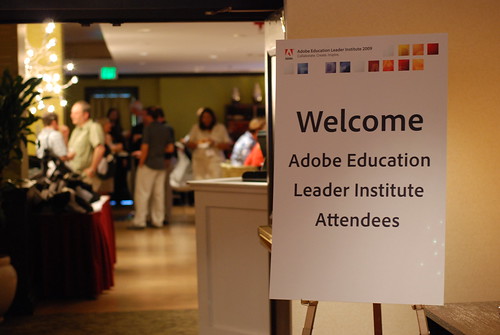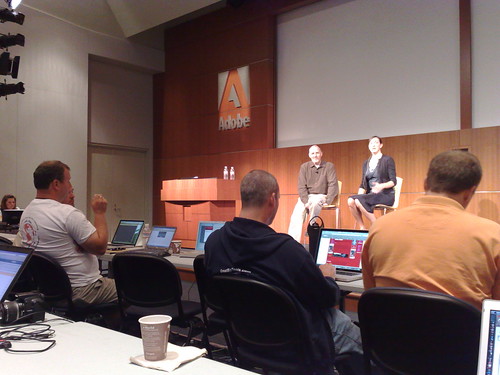I’m in Auckland at the moment for the first New Zealand National IWB Conference. As some of you may know, I co-authored a book a while back with Mal Lee that was all about IWBs and interactive technology in general, and I learned a fair bit about whiteboards and their various uses in the process of writing that book. I’ve presented at the last three Australian IWB conferences, another in Napier earlier this year, and now this one in Auckland. Plus, since the book came out I get asked quite a lot to run IWB workshops for schools, where I get to I talk to lots of teachers about the things they do with their IWBs. (Actually I’ve always talked to lots of teachers about their IWB use, but I think I ask much better questions these days). All of this has given me – I think – a reasonable perspective on the current state of IWB use, so I just thought I’d blog a couple of reflections about it.
When I first saw an interactive whiteboard, I really wasn’t very impressed with what I saw. I remember touring through a school in southwest Sydney about 5 years ago that had installed them in every room. As I wandered around looking at how they were being used, a few thoughts struck me…
- I couldn’t see anything special about “the board”. It seemed that everything I saw being done could have been done with just a projector on its own equally as effectively.
- There was nothing terribly special or even pedagogically sound about what I saw. It was mostly just online games and digital “busy work”.
- I wondered if these people had given any thought to how much their ongoing costs for replacement projector bulbs would amount to!
Shortly after that, I was asked if I would help develop some digital teaching resources for teachers using IWBs. I recall it was myself and another teacher who were commissioned to create this package, and I think we had 5 days to work on it, but I spent most of the first three days arguing with her about how stupid some of these whiteboard activity ideas were. Mind you, I was a high school teacher and she was a primary school teacher, and were both coming at it from completely different paradigms. Eventually we did come up with some good ideas, but I felt like the process of arguing and questioning the value of the IWB actually brought us to a far clearer realisation about what exactly these IWB things were all about. Or at least what they could and should be all about.
When I was teaching in Canada, my school adopted Smartboards. I was lucky enough to be selected for the original “pioneer group” of teachers there, and we got some excellent training directly from the trainers at Smart. Over the last couple of years I’ve read a lot of research papers and blogposts about IWBs, listened to a lot of IWB specific podcasts, watched a lot of teachers work with them, had many, many conversations about them with all sorts of teachers. And, of course, I’ve co-written what has turned out to be a pretty comprehensive book on the subject.
There are still some people who have some pretty negative opinions about IWBs. They claim that interactive whiteboards are a backward step. Coming from my originally skeptical position, I totally understand the controversy surrounding IWB technology. However, I also feel like I’m reasonably well qualified to have some sort of considered opinion about them, so here’s a few thoughts…
I feel like the general attitude to IWBs and the approach to using them seems to have matured somewhat over the last 12 months. In the early days of IWBs, many teachers were clearly impressed with the “wow factor” and were not giving a lot of deep consideration to the actual pedagogy for their more meaningful use or thinking about how they might become seamlessly embedded into the daily routine of teaching and learning.
These days however, I’m pleased to say that most of the conversations I hear about IWBs seem to have a much more pedagogically focused outlook. More teachers seem to be thinking intelligently about how they might be used to improve learning, or at least raise the student engagement factor in some sort of sustainable way. They want to know about how to use the technology to deepen understanding and to promote higher order thinking skills. They genuinely want to become more proficient in their use, so they can get the technicalities of using them out of the way and focus on the real issues of “how will this help me teach better, and how will this help my students learn better?”
It’s becoming much harder for vendors to dazzle educators with fancy animations and meaningless drag-and-drop activities. It seems to me that the IWB-using educators I’m meeting these days are much more discriminating and thoughtful about how they use the technology. They also have a far more suspicious view of outrageous vendor claims about the instant impact an IWB will have on their classrooms. For way too long, vendors promoted IWBs as though they were some sort of magical panacea for classrooms. “Just add an IWB to your classroom and student excellence will automatically follow!” seems to be the claim.
From what I’ve seen lately, that claim is being increasingly seen for the lie that it is. Intelligent teachers know that while interactive whiteboards might be a powerful addition to their classroom, expecting them to be more than that is just naive. Great teaching is still the catalyst that makes powerful learning possible, but used wisely, IWBs can certainly enrich that environment.
Technorati Tags: iwb, pedagogy


 I’m finally back home from a fantastic week in San Jose at the
I’m finally back home from a fantastic week in San Jose at the  Tuesday started early for me with a Photoshop exam. This was taken as part of the
Tuesday started early for me with a Photoshop exam. This was taken as part of the  Thursday was another full day of learning, with a intense session run by Adobe’s
Thursday was another full day of learning, with a intense session run by Adobe’s  The rest of Friday morning was a general wrap up of the event, with feedback and a debriefing session between the AELs and the Adobe folk. It was kind of sad to have it all come to an end, but we eventually said our goodbyes and all went our separate ways. The sessions were all recorded with Adobe Connect, as well as a ton of
The rest of Friday morning was a general wrap up of the event, with feedback and a debriefing session between the AELs and the Adobe folk. It was kind of sad to have it all come to an end, but we eventually said our goodbyes and all went our separate ways. The sessions were all recorded with Adobe Connect, as well as a ton of